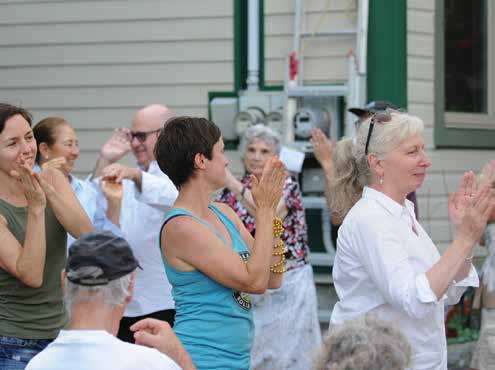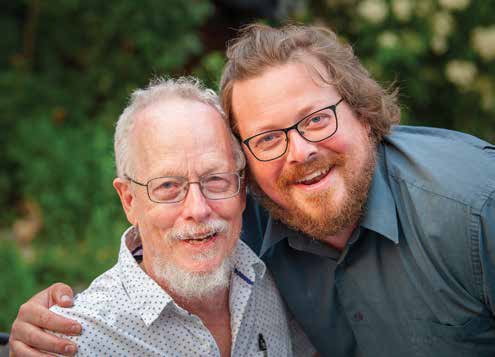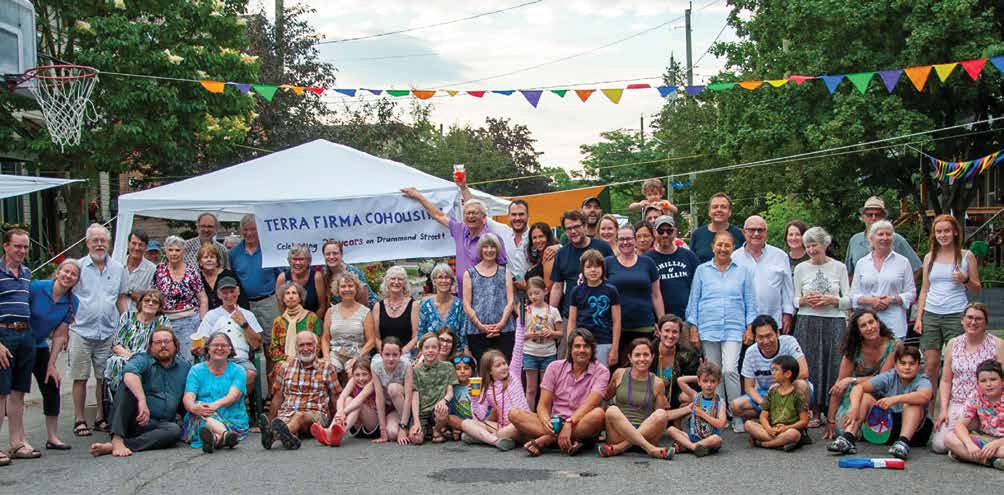Mainstreeter Staff
In this issue of The Mainstreeter, we toast the families of Terra Firma
who recently celebrated their 25th year of community living within
the visionary cohousing venture on Drummond Street in Old Ottawa
East. Five years in the planning, Terra Firma launched its pioneering
housing concept in 1997 and, remarkably, every family that
purchased a unit at the outset of the bold initiative remains there
today, enriched immeasurably by the experience.
In conversation with two of the co-owners, Suzanne Gagnon and
Steve Fick, and joined by their Herridge Street neighbour, Rachel
Thibeault, The Mainstreeter gained an appreciation of the vision
that motivated the founders to launch Terra Firma and a sense of
how their lives have unfolded living in an alternative urban housing
arrangement and raising children in a multi-family environment.
Terra Firma neighbour Paul Scott was a guest at the recent 25th
anniversary party on Drummond and snapped the photos adorning
this interview.
The Mainstreeter: Let’s begin with an explanation of what Terra Firma is, and what it isn’t. As we understand it, Terra Firma is not a housing cooperative, but rather a cohousing arrangement established as a condominium. Can you explain the difference?
Steve Fick: We are organized legally as a condominium since all of us own our units. That’s the main difference between our cohousing situation and a housing co-op since people living in a co-op would not typically be owning their own unit. Each household has its own private unit, and we have shared physical indoor and outdoor amenities – as do most condominiums. But we are more than a condominium since we all share a commitment to social interaction and community-building. Cohousing is a loose concept, and it can take many forms asis the case with cohousing groups in Europe and throughout North America. And while they are all different, the basic overriding principle is intended to foster community.
The Mainstreeter: As you reflect on the 25th anniversary of Terra Firma, and as original co-owners, can you comment on how closely the reality of more than two decades of living together here has tracked with the original vision that inspired you to purchase your cohousing units back in 1997?

Terra Firma families, friends and neighbours celebrated 25 years of cohousing and community at a lively Drummond Street party in late June. Photo by Paul Scott
Suzanne Gagnon: For me, cohousing is my peace project. What I mean by that is that I’ve always wished for peace in the world. I figured that if I can live in peace with others in a community setting, then I will know that peace in the world is possible. Now, here we are 25 years later, and I can see how difficult it is to maintain peace and harmony. I can now better imagine what it’s like when we’re talking about world issues, and people trying to find ways to compromise, negotiate, and struggle to hear each other. So, it’s been exactly what I was hoping for in the beginning, to gain experience in achieving peace and learning how much you have to be open to diversity, and how much you have to be open to yourself and let go of some thoughts and opinions you might have in order to find peace and harmony living next to others.
Steve Fick: In terms of living here for the past 25 years, I would say overall, it’s been better for me and my family than I could have imagined. And that’s in relation to all the basic things that I desired – a sense of community, cooperation, and personal growth. Those have all happened in spades. And a lot of personal growth comes about through the challenge of community living. Every group of people is going to have a variety of concerns and conflicts. But I guess for me, one of the core understandings I have come to realize is that it’s not about our competing views of utopia. It’s about all of us working together to make this situation the very best it can possibly be.
The Mainstreeter: It’s interesting that you both focused on trying to live in harmony with others and with your surroundings, and the challenges that arise in trying to do that. I wonder if you can think back to the founding days of Terra Firma and identify some of the challenges that you experienced at the outset in getting a cohousing initiative off the ground here in Old Ottawa East back in 1997?
Suzanne Gagnon: I think for me, the fact that we managed to do all of this on our own is a major thing. Doing this with very little experience and maybe with too much idealism was challenging. And once we found a place to establish Terra Firma, we had to engage professionals who had little understanding of what we wanted to achieve. For example, when we hired legal advice, the lawyers were trying to write things into our documents that would protect each of us from the other. They would always be thinking about what could go wrong and how we could protect ourselves. Because that’s what they’re used to thinking about – rules to protect an individual against another individual. And we were saying “no, no, we want to live together” and we don’t want that kind of protection against our neighbours doing something to hurt us.
Finding a mortgage was also a big challenge for us. We ended up hiring a mortgage broker because no bank understood the concept of cohousing. We also didn’t have the name of a developer behind us. They didn’t know who we were and why they should trust us. Those were some of the challenges of the initial days. Today, it’s a little easier to get professional advice. Architects now understand the concept of cohousing, and developers might be more supportive.
The Mainstreeter: After the initial few years, and once things were up and running, did Terra Firma have any mid-life crises or was it all pretty much smooth sailing?

Terra Firma cohousing owners Suzanne Gagnon and husband Fred Simpson:“…the fact that we managed to do all of this on our own is a major thing!” Photo by Paul Scott
Steve Fick: Well, no relationship is entirely conflict-free, but honestly, I think we’ve done really well dealing with the occasional situation of potential conflict that emerged over the years. In any group of people, you have different degrees of ability or skill to manage conflict. I do couples counselling, and some of the conflicts we’ve seen at Terra Firma are the same conflicts you’ll find in a human relationship – money, how you spend your time, cleanliness, the sort of things you would expect to be challenged in any social group.
And in any kind of relationship, including cohousing, there’s sort of a honeymoon phase. And then when a conflict arises, some might think that’s the beginning of the end. But in my mind, it’s the beginning of the beginning. That’s when you really start to grow the relationship. That’s when you grow your maturity.
Suzanne Gagnon: Certainly, Terra Firma has helped me realize that conflict is a good thing. While I was educated to think that conflict is a bad thing, you either run from it or you just kind of dig in and deal with it. I saw a conflict here as the emergence of something. If you don’t explore it, you lose the incredible energy it has. In this particular housing context, conflict was an opportunity to hear a diversity of views. It was an opportunity to be patient. It was an opportunity to experience true communion, in the sense that the whole is bigger than the sum of its parts. If you were able to stay with the conflict and ride it through, you realize you’ve come through a powerful experience. It’s more than what I was ever expecting, and I started to see different viewpoints in a good light.
I realized that when challenges arise in a situation where you trust everyone, you will probably find the right solution as long as all the voices are heard. If you don’t trust the others, well that’s where it might break apart. It’s that trust factor that’s key, and it is what was important for us to build trust at the beginning because that’s what became the safety net for future difficulties that might come along.
The Mainstreeter: Rachel, you have been a next door neighbour of Terra Firma for 25 years, pretty much since it began. What of your own perspective on this cohousing venture – has it changed over time and, if so, how?
Rachel Thibeault: What I found interesting,
those times I would be invited for dinner or to spend time in the common area of Terra Firma, was the shared vision of living together and creating community. As a witness, there was something really comforting for me to see that the decision to live “in community” could actually take shape and succeed in an urban setting. In fact, it was comforting to me on many levels, because I live so close – even the creation of the green space; there’s something extremely soothing about having this green space at Terra Firma that seems to radiate through the neighbourhood. And the events they have here help to create focal points for the community. We don’t have too many opportunities to bring people together. And so Terra Firma has become like a pivot or a magnet that, at times, creates platforms for community to come together.

Co-owner Steve Fick, pictured here with his son Galen who grew up in community at Terra Firma: “… the benefit for children and for families was profound.” Photo by Paul Scott
The Mainstreeter: It’s something of a testament that all of the original owners within Terra Firma still live here and have raised their families here. What has it been like to raise a family in this cohousing setting, and what was it like for your kids growing up here?
Steve Fick: For my kids, felt like they had multiple parents. My son, for example – whenever he would return from being away he would go around and visit all the families. And if there was a crisis in our family, we knew the wagons would circle around us for protection. One testament is that all of our kids have lived in various places around the world. But our daughter came back to start a daycare in this neighbourhood, and right now she’s living with us while she gets some more schooling. Our older daughter has returned to live near us after living in Europe for many years, and she’s raising her family here at Terra Firma… So, I’d say the benefit for children and for families was profound.
Suzanne Gagnon: Well, my son (Thoma Simpson, 29-years-old) just came through the door with my grandson who still lives here. Thoma – how did you enjoy growing up at Terra Firma?
Thoma Simpson: One word comes to mind – fun! It was fun to grow up in a community like this with different households, different views, and different sorts of parents to model from. It definitely shaped my worldview and my ability to work with others, to collaborate and to foster a sense of community in everything that I do. It definitely was enjoyable living in a housing community, and it’s been proven that community living has some strong benefits to mental health as well.
I moved out for four years and lived in an apartment nearby, but there is definitely a lot of appeal to moving back here where my son could grow up in a community like this. The number one attraction is a backyard with greenspace. Being able to come back here, there’s a lot more kids on the street this time around than when I was younger. So I was glad to come back and give my son some of the upbringing that I had the privilege to have here at Terra Firma.
The Mainstreeter: What have been some of the more significant successes of Terra Firma over the years?
Suzanne Gagnon: Well, to quite an extent, the members of Terra Firma have been determined to instigate change not just within our housing group but across our broader community. Our members have built platforms to facilitate community growth with real success. They have been instrumental in establishing the Children’s Garden, the community garden in Old Ottawa East, the Farmers’ Market, our environmental group – SLOE – and the nature trail along the Rideau River and our redesigned Main Street. So these are just some of the beneficial by-products to the broader community from those who chose to start Terra Firma.
We often find that people come here to learn about Terra Firma, and how cohousing works in reality. People are wanting to do something similar. So, for us to have success makes people realize, oh, this is possible. And when you think something is possible, then you have the motivation to try it yourself.

Singing, dancing and a giant parachute canopy were among the highlights of the 25th anniversary street celebration that captured the spirit of Terra Firma and its founding families. Photo by Paul Scott
Steve Fick: We had a vision of a better way to look at how we could live in the community. And, I’ve always thought we were really, really lucky. This is a great group of people, and we’re the ones who sort of stuck with this initiative during the five-year planning period before we purchased and moved in. Over that period of time, there were actually about 125 people involved at one point or another. Some people just got tired of waiting for it to come to fruition, but others stuck with it, which is what we did. It wasn’t always easy waiting, and there were financial issues as well.
It’s one thing to have the idea, but are you willing to put money behind that idea – to me, that’s where the rubber hits the road. You know, are you willing to put $1,000 into the pot to collectively hire a lawyer? And to do that when you still don’t really know if it’s going to work? So it’s an investment. You have to understand that while there is certainly a vision, at some point in order for it to happen, there has to be some degree of reality that goes with it. So it’s really not about utopia at all.
Suzanne Gagnon: What I find deeply comforting about our years in Terra Firma is to see the concept of people living in a community and seeking to build and benefit the community has worked. Often these concepts remain very esoteric, and we see very few actual cases where the values take shape and flourish. And, certainly, for me, the main takeaway is that with all the goodwill we’ve put in, it has worked, worked for us individually and worked for the surrounding community.







